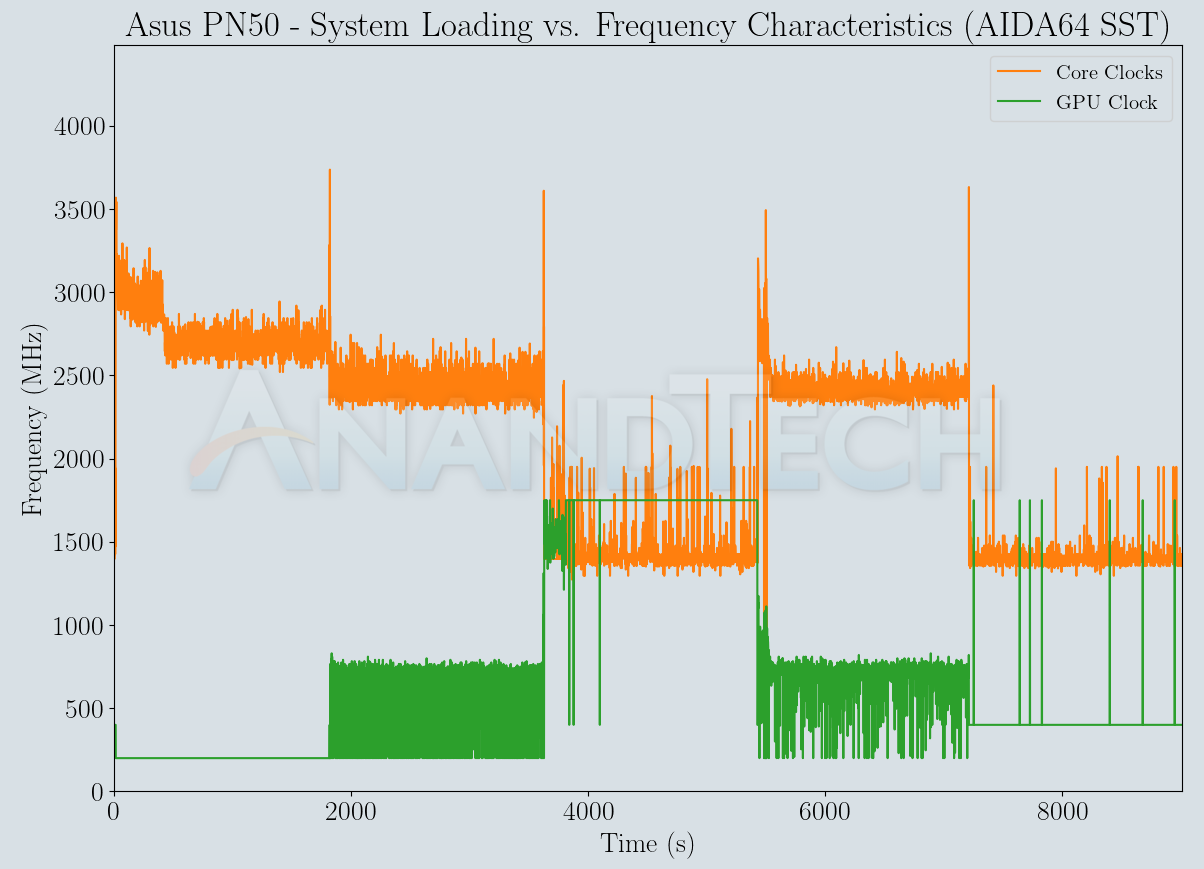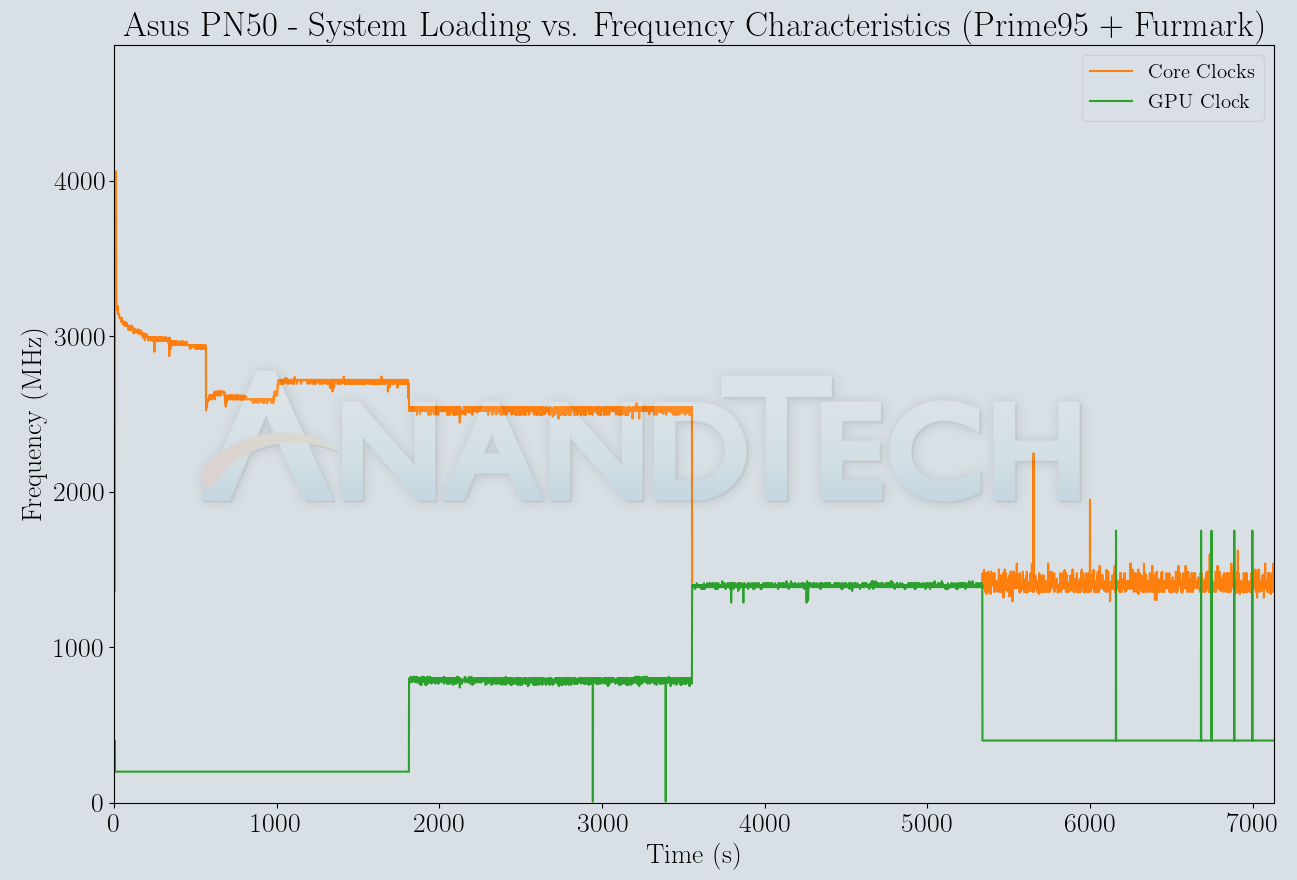ASUS PN50 mini-PC Review: A Zen 2 Business NUC
by Ganesh T S on October 1, 2021 10:00 AM EST- Posted in
- Systems
- AMD
- Asus
- NUC
- UCFF
- Mini-PC
- Zen 2
- Ryzen Embedded
- Renoir
- Ryzen 4000
- Ryzen 7 4800U
Power Consumption and Thermal Performance
The power consumption at the wall was measured with a 4K display being driven through the HDMI port. In the graph below, we compare the idle and load power of the ASUS PN50 with other low power PCs evaluated before. For load power consumption, we ran the AIDA64 System Stability Test with various stress components, as well as our custom stress test with Prime95 / Furmark, and noted the maximum sustained power consumption at the wall.

Thanks to the use of a low-power SSD and lesser amount of RAM compared to systems such as the 4X4 BOX-4800U and the NUC BOX-1165G7, the PN50 makes an appearance in the middle of the chart for idle power. The system is placed second in terms of peak load power consumption, coming behind the Tiger Lake system.
Our thermal stress routine starts with the system at idle, followed by four stages of different system loading profiles using the AIDA64 System Stability Test (each of 30 minutes duration). In the first stage, we stress the CPU, caches and RAM. In the second stage, we add the GPU to the above list. In the third stage, we stress the GPU standalone. In the final stage, we stress all the system components (including the disks). Beyond this, we leave the unit idle in order to determine how quickly the various temperatures in the system can come back to normal idling range. The various clocks, temperatures and power consumption numbers for the system during the above routine are presented in the graphs below.
| ASUS PN50 System Loading with the AIDA64 System Stability Test | |||

The average frequency of the cores stays well above the rated 1.8 GHz whenever the CPU is loaded. GPU clocks range from 200 MHz at idle to around 1.7 GHz at full load. On the temperatures side, we see throttling kick in when the cores reach around 95C. The iGPU itself doesn't cross 85C even under load. Under stress, the SSD does reach around 75C - pointing to the need for a thermal pad or some other thermal solution for the storage device. The at-wall power consumption stays between 40 - 45W (with package power contributing 25W) prior to throttling. After the temperature reaches 95C, the package power drops down to 20W, and the at-wall number comes down to around 35W. In contrast, the ASRock Industrial 4X4 BOX-4800U using the same SoC sustains a package power of 15W under load. This explains the reason for the ASUS PN50 outscoring the 4X4 BOX-4800U across many benchmarks.
p>
The custom stress test involves running Prime95 for 30 minutes, followed by the addition of the Furmark stress workload. After 30 minutes, the Prime95 load is removed, and the Furmark workload is allowed to run for 30 minutes. The system is then left idle for 30 minutes.
| ASUS PN50 System Loading with Prime95 and Furmark | |||

The core and GPU frequencies behave similar to he AIDA64 SST, though Furmark limits GPU frequency to around 1.5 GHz. Throttling kicks in after the core temperature hits 95C, and we see the 25W to 20W package power transition play out in this case also.
Overall, the thermal solution in the Asus PN50 is perfect for a 20W TDP configuration. Asus seems to allow 25W TDP operation until the thermal solution is overwhelmed. Once the core temperature hits the 95C threshold, the operating TDP is scaled down to something more manageable for the form factor and thermal design of the system.










32 Comments
View All Comments
deil - Monday, October 4, 2021 - link
I have R5700 version of this, and I can tell you that if you add thermal pad the chassis which is full aluminum, it doesn't throttle on 25W. This thing has more cooling than laptops with the same CPU.Mine is TV mounted, and then it's not running a fan at a level I can hear.
Toadster - Friday, October 1, 2021 - link
isn't NUC an Intel name?Samus - Friday, October 1, 2021 - link
Indeed, but it appears the NUC platform is slowly becoming an industry design blueprint instead of a product line. Quite frankly I'm glad this segment is crossing the business-application barrier because there are some substantial benefits to these over, say, an All In One.nandnandnand - Saturday, October 2, 2021 - link
Their fault for calling it "The Next Unit of Computing".evilspoons - Saturday, October 2, 2021 - link
It is, yeah. ASUS calls it a "4x4" as in 4 inch by 4 inch system, which is the generic term. Anandtech calling this a NUC is like referring to Scotties facial tissues as "Kleenexes".Threska - Friday, October 1, 2021 - link
Hmmm. if I use a viewfinder I can hold this article up to my eyes for a stereo effect. :-Dabufrejoval - Friday, October 1, 2021 - link
Ordered a 4800U based PN50 in Summer 2020, listed by the e-tailer as "due next week".It was to become a small low-power but "sprinty" hyperconverged server with a full complement of 64GB of RAM to complement the 8 cores and "max SSD", potentially in a cluster of three if it turned out any good.
Among the most important criteria was very low idle power and “unnoticeable” sound emissions under all loads.
Saw the delivery date slip further and further until it became "unknown".
Cancelled the order and got all three last generations of Intel NUCs within a couple of months (NUC8i7BEH, NUC10i7FNH and NUC11PAHi7), less by design than by market opportunity: they were the only kind available at each point in time and I seem to have been rather lucky with the prices, too (today they all have far higher listings and no availability).
I also got a Lenovo Ultrabook with the Ryzen 5800U as a point of reference, which unfortunately can't be strong-armed into server duty while off-duty as a laptop, for lack of RAM expansion, even if it was hardly more expensive than a similarly equipped PN51 would be, …if it were available: it's quite simply a crazy market!
They all confirm your benchmark findings, but it's rather unfortunate that you don't include power consumption figures for the benchmarks as well, because they are very informative in terms of chip technology and other side effects (noise and energy).
The best thing about the Intel NUCs is their configurability in terms of P1, P2, TAU and fan parameters: You can really tune these machines to your ratio of noise tolerance and performance, effectively making them fit anywhere in the 8-35TDP (sustained) range and matching turbos.
Throughout my own benchmarking I found that the IPC improvements of Tiger Lake vs. the 14nm Comet/Cannon Lakes had the Gen11 quad-core achieve the same multi-threaded performance as the Gen10 hexa-core, on turbo or even after fitting to the 15 Watt envelope on long running workloads.
At the same time Tiger Lake and the Ryzen 3 were also very much the same performance core-by-core when running at the same clock speeds. It’s just much easier to have the Tiger Lake NUC clock higher than a Ryzen U (or any Ryzen for that matter), which has it gain the single threaded crown, ...unless you regulate the power to cut noise.
Because when you force Intel’s CPUs and Ryzen 3 to the same Wattage (=source of noise), Tiger Lake’s single threaded lead is gone, while the older 14nm chips start to really show their age.
Since I wanted to have them run “unnoticeable” under sporadic and sustained loads, I played with the P1, P2, TAU and fan curves to give a bit of turbo leeway for sporadic or interactive loads, while I made sure that they’d clock down before having to rev up the fans too high.
That can be another important differentiator when you want to deploy these for long-term office (or light server) use: These small fans love to eat dust and clog the vent openings when they spin.
You can get a lot more CPU performance out of the 7nm Ryzen 3 for the same heat than from any current Intel.
What I really wanted was all of these in a Mini-ITX form factor with large slow Noctua fans, but that seems a niche even worse served than the NUCs with these low Wattage but speedy SoCs.
And while it’s nice to know that these nice passive cooling replacement chassis exist for Intel NUCs, a somewhat intermediate option (big slow fan, much lower price) is still missing.
Yes, the Xe iGPU beats the Vega8 significantly, even when both share identical DRAM bandwidth (~50GB/s on my systems) and actual power.
But all of these are just terrible at gaming, while they are all quite good for 2D at 4k Linux or Windows.
abufrejoval - Friday, October 1, 2021 - link
I can't imagine that Ryzen 2 APUs are still being produced: They'd compete for the very same foundry capacities as Ryzen 3 APUs.So now that PN50's are finally coming, that means these are what's left over after nobody buys them in notebooks any more.
This means all theoretical long-term and mass deployment benefits of this form-factor, doesn't apply to this product any more.
Caveat emptor!
meacupla - Friday, October 1, 2021 - link
It takes money and time to retool foundries and half of the 5000U series still uses 4000U parts which are just renamed in bios.abufrejoval - Saturday, October 2, 2021 - link
Actually there was an article here by Ian which pointed out, that in fact the Lucienne chips were not just renamed Renoirs even if they share the same Zen2 cores and a very similar iGPU: There is supposed to be significant updates in power management, which may be somewhat more beneficial for battery operated devices.https://www.anandtech.com/show/16451/amds-ryzen-50...